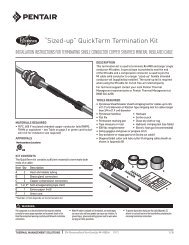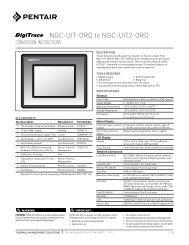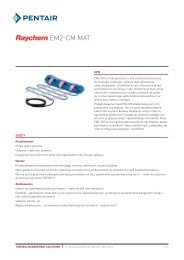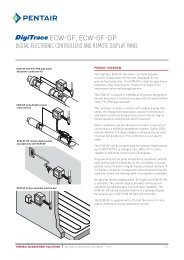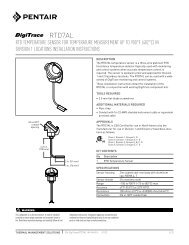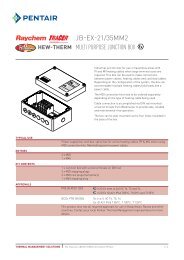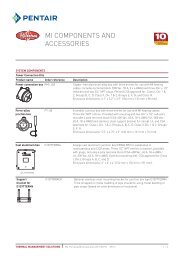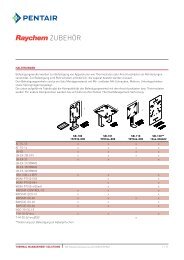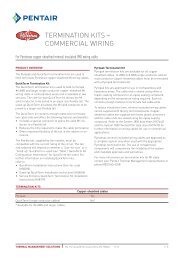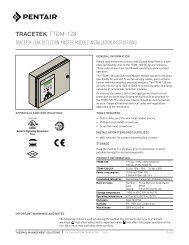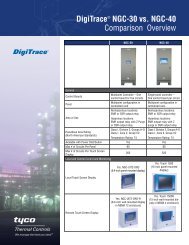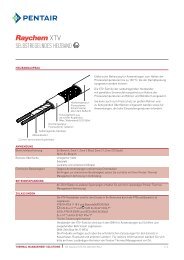DigiTrace 920 Series Heat Trace Controller - Pentair Thermal ...
DigiTrace 920 Series Heat Trace Controller - Pentair Thermal ...
DigiTrace 920 Series Heat Trace Controller - Pentair Thermal ...
Create successful ePaper yourself
Turn your PDF publications into a flip-book with our unique Google optimized e-Paper software.
5.3 Load Shedding Control ModeLoad shedding is a control mode that can be programmed and initiated only by an externalcommunicating device, or by the Model 780/GCC-9000 Group Communications <strong>Controller</strong>, whichoverrides temperature control and forces the output of the controller OFF until reset by the 780/GCC. When using a GCC, load shedding is initiated by a contact closure (or opening) on one ofthe four contact inputs. Each contact input initiates a load shedding command for the group ofcontrollers associated with that contact input. Each controller may be associated with one or moregroups. Refer to the Load Shedding Section in the GCC manual for details on setting up the loadshedding features of the HTC when using a GCC.When power is applied to the controller, it determines if load shedding mode has been enabled.If enabled, the controller immediately enters load shedding operation (holding its output off)and waits to see if the GCC or an external communicating device has initiated a load sheddingcommand. If no command is present the controller resumes normal operation. If a load sheddingcommand is present, the controller will continue to hold the output OFF, until one of threeconditions occurs:1. The GCC contact input or zone definition bits of an external communicating device whichinitiated load shedding clears and the command to terminate load shedding mode is issued.2. Communications are interrupted between the controller and its communicating device, as inthe case of a damaged communications wire. Approximately 30 seconds after communicationsceases the controller will return to normal operation.3. Communications between the controllers and the external communicating device goes off-linefor approximately two minutes, as occurs when the 760 Hand Held Programmer is used tocommunicate with the controller.IMPORTANT: The controller will return to normal operation if communications between the 780or external communicating device and the controller are disrupted in any way. This will returntemperature control to the HTC. Also, the HTC does not perform a periodic autocycle test whileoperating in load shed mode. When using a GCC, it must be configured for load shedding operationbefore the controller can be set up for load shedding control.Three parameters must be set in the controller to configure it for load shedding operation:1. The load shedding feature must be enabled.2. The FAIL SAFE MODE parameter must be enabled or disabled depending on the applicationrequirements. If FAIL SAFE MODE is enabled, then at least one LOW TS ALARM (of a TS usedin the TS CONTROL MODE) must be enabled. If the alarm temperature exceeds the CONTROLSETPOINT temperature, fail-safe mode will be disabled.3. The GCC contact input(s) or zone definition bits of an external communicating device that are tobe associated with the load shedding action for the controller must be defined.These parameters can only be configured using an external communicating device or theModel 780/GCC-9000 Group Communications Con-troller. Refer to the Model 780/GCC-9000user manual for details on how to set up these options. The optional <strong>920</strong> Operator Console canbe used to enable or disable the load shedding feature, but not to set any other load-sheddingparameters.IMPORTANT:• Fail-safe mode is always disabled if the SWITCH CONTROL MODE is set to either of the twoproportional ambient control modes, or the TS CONTROL MODE = EXT INPUT, FAIL OFF/ON• Fail-safe mode is disabled if the TS CONTROL MODE is set to either EXT INPUT, FAIL TS 1 orEXT INPUT, FAIL TS 2 and a control temperature failure occurs.• The HTC will turn on its output switch when the control temperature becomes less than thehighest LOW TS ALARM temperature if the fol-lowing conditions are met:– Fail-safe mode is enabled– Load shedding is active– The TS CONTROL MODE uses both TS 1 and TS 2– Both TS 1 and TS 2 have their LOW TS ALARMS enabled• A FORCE ON override signal has higher priority than a load shedding signal. An INHIBIT signalhas higher priority than fail safe mode.THERMAL MANAGEMENT SOLUTIONS EN-<strong>Digi<strong>Trace</strong></strong><strong>920</strong>series-IM-H56874 04/1351 / 82



